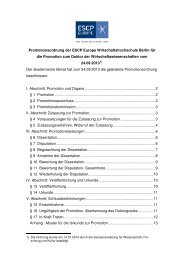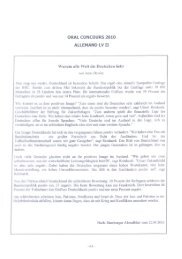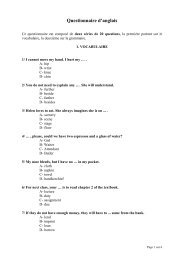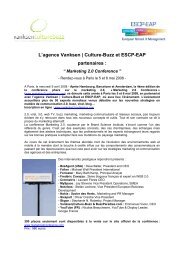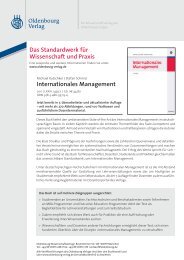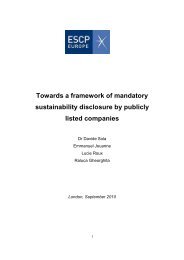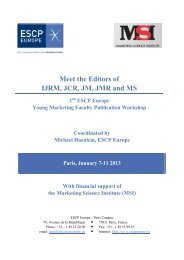WP 53_Jacob_neu - ESCP Europe Business School
WP 53_Jacob_neu - ESCP Europe Business School
WP 53_Jacob_neu - ESCP Europe Business School
You also want an ePaper? Increase the reach of your titles
YUMPU automatically turns print PDFs into web optimized ePapers that Google loves.
more ambiguous (as Anderson, Thomson, and Wynstra 2000 found for “value” of<br />
a market offering; p.308). 2<br />
Studies in behavioral decision making however are predicated on incomplete<br />
information, i.e., a lack of information about aspects of performance of<br />
alternatives, attributes, and/or their value entails uncertainty. 3 In addition, there<br />
are manifold facets of a market offering that may be tainted with uncertainty.<br />
Consequently, literature on uncertainty is replete with classifications of<br />
uncertainty that are in sum partially redundant. In finding dimensions of<br />
uncertainty we screened a variety of typologies. We aimed at building a concise<br />
classification of facets of uncertainty pertaining to the industrial procurement<br />
decision-making.<br />
We divide extant types of DMU in three classes; (a) DMU pertaining to the<br />
specific market offering, (b) DMU related to the specific supplier of the market<br />
offering, and (c) DMU related to the customer. In the following, we consolidate<br />
findings from a review of uncertainty typologies.<br />
2.1 Market Offering-related Decision-Making Uncertainty<br />
We draw from conceptual work in operations management (Gerwin 1988) and<br />
business marketing (Håkansson, Johanson, and Wootz 1976) to elicit market<br />
offering-related facets of DMU. In the course of a review of relevant literature, we<br />
group technical-, financial-, social-, transaction-, and market uncertainty in this<br />
class.<br />
Technical Uncertainty. Technical uncertainty relates to the “difficulty in<br />
determining the precision, reliability, and capacity of new processes, and whether<br />
still newer technology may soon appear to make the equipment obsolete”<br />
(Gerwin 1988, p.90). Gerwin had “Computer-aided Manufacturing Technology” in<br />
mind when reasoning about different kinds of uncertainties that may hamper its<br />
adoption process. More generally, Lehmann and O'Shaughnessy (1974) define<br />
technical uncertainty “as the chance that the product will not perform as<br />
2 “Purchasing managers are more knowledgeable about using price and price changes<br />
as a basis for selecting product offerings than value and value changes. In business<br />
markets, the price of each product offering is almost always stated or understood<br />
(Heinritz et al., 1991). The same cannot be said about value. Even when the value of<br />
a product offering is known, purchasing managers likely will have far greater<br />
experience using price information than value information” (Anderson, Thomson and<br />
Wynstra, 2000, p.310).<br />
3 Downey and Slocum, 1975, p.570: “Reviewing the manner in which uncertainty has<br />
been employed, Duncan (1972) identified three basic definitions in the literature, all<br />
of which are explicitly or implicitly grounded in the concept of information as a<br />
counterpart of uncertainty.” Uncertainty has been similarly defined by McQuiston,<br />
1989, p.70: “Organizational buying theory states that when members of a decisionmaking<br />
unit are faced with uncertainty, they seek to reduce it through the gathering<br />
of more information (Sheth 1973; Webster and Wind 1972; Cyert and March 1963).”<br />
See also Dawes, Lee and Dowling, 1998; Bunn, 1993; Puto, Patton and King, 1985;<br />
More, 1984; Anderson, 1982; Spekman and Stern, 1979; Assmus, 1977; Sheth,<br />
1973; Hickson, Hinings, Lee, Schneck and Pennings, 1971.<br />
3



